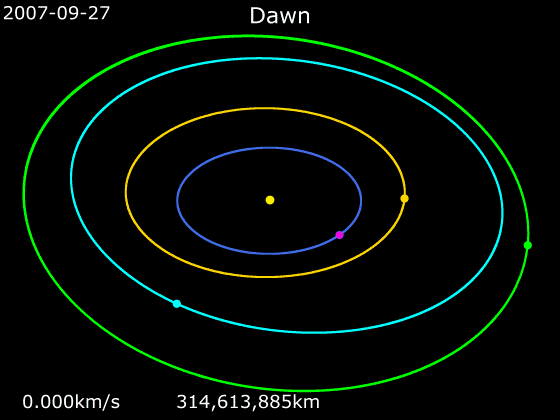Dawn Mission was a remarkable journey to the earliest objects discovered in the asteroid belt: Giant Asteroid Vesta and Dwarf planet Ceres.
Mission Objectives
NASA’s main goal was to understand the origin and evolution of our solar system. Visiting Ceres and Vesta was crucial for this as these protoplanets were some of the earliest objects to form alongside other planets. The three major scientific objectives for the mission were:
Capture the earliest moments in the origin of solar systems and realize the conditions under which these objects formed.
Determine the nature of building blocks of planets to improve our understanding of the formation of terrestrial planets.
To gauge the difference between Ceres and Vesta which followed different evolutionary paths to understand what parameters control that evolution.
Dawn Spacecraft
Solar Arrays: Solar arrays are 8.3 meters long and 2.3 meters wide each. On these arrays are 11480 individual photovoltaic cells which can convert 28% of solar energy it receives into electrical energy. These arrays had a gimbaled connection which allowed them to rotate any desired angle to face the Sun.
Antennas: Dawn had 2 types of antennas onboard, for communication with the earth through NASA’s Deep Space Network. And only one of those could be used at a time. It had 1 Large 1.52-meter diameter parabolic High-Gain antenna and three low gain antennas for when the spacecraft was not pointing high-gain antenna towards Earth.
Science Payload
Framing Camera: FC mapped Vesta and Ceres through the clear filter and 7 bandpass filters allowing the wavelengths from visible to near-infrared. The camera was used for understanding surface geomorphology and physical parameters of the asteroids as well as for orbit navigation.
Visible and Infrared spectrometer: VIR spectrometer consisted of 3 modules Optical system, proximity electronics, and cryocooler. It could see from 0.3 to 5 microns covering near-ultraviolet, visible and infrared regions of the spectrum.
Gamma Ray and Neutron Detector: The instrument allowed spacecraft to measure the elemental composition of Ceres and Vesta. A total of 21 sensors with a wide field of view was used to detect energy from gamma rays and neutrons that were reflected or emitted by celestial bodies. It could reveal atomic constituents of the surface of Ceres and Vesta down to the depth of 1 meter.
Ion Propulsion
Dawn spacecraft has three 41-centimeter-diameter ion thrust units(8.9 kg each) which are movable in two axes to control spacecraft attitude. Two of these thrusters were necessary to complete the mission but a third one was carried as a spare. These thrusters work by using an electrical charge to accelerate ions from xenon fuel up to a maximum rate of 3.25 milligrams per second.
The Dawn carried 425 kg of xenon propellant at launch and was stored in a compact form(1.5 times denser than water at launch) onboard the spacecraft. ‘Xenon’ was selected as propellant due to its chemical inertness and the atoms are relatively heavier compared to other propellants which help provide larger thrust. At max. Thrust, each engine is capable of producing 91 millinewtons - almost the same amount of force with which we can hold a piece of notebook paper in our hands.
Key Facts
Dawn is the first spacecraft to orbit two destinations in space.
The record powered flight: Ion propulsion was active for 5.9 years(54% of the time in space as of 7th Sept 2018).
Dawn was able to travel to 2 destinations for the price of one by using Ion-engine technology.
Dawn's mission is the first to orbit a main-belt asteroid and the first to reach a dwarf planet.









No comments:
Post a Comment